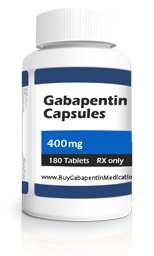COMMON USES: This medicine is an anticonvulsant used to treat seizures associated with epilepsy. It may also be used to treat nerve pain along with back and joint pain.
Alleviate Nerve Pain with Gabapentin
Do you suffer from nerve pain, restless legs syndrome, or seizures? Gabapentin 400mg can help alleviate your discomfort. This prescription medication works by reducing the amount of certain chemicals in the brain that causes pain and seizures. It is typically taken orally, with or without food, and as directed by a healthcare provider.
Effective Relief for Multiple Conditions
In addition to treating nerve pain, Gabapentin can also help with restless legs syndrome and seizures. It is a versatile medication that offers effective relief for a variety of conditions. With Gabapentin, you can experience relief from discomfort without the worry of harsh side effects.
Easy and Convenient Dosage
Taking Gabapentin is easy and convenient. Simply take it orally with or without food, and as directed by a healthcare provider. Gabapentin is a safe and effective way to treat your pain and discomfort.
-
- Gabapentin 400 mg
- 30 Tablets
- $119.00
- Buy Gabapentin
-
- Gabapentin 400 mg
- 90 Tablets
- $149.00
- Buy Gabapentin
-
- Gabapentin 400 mg
- 120 Tablets
- $169.00
- Buy Gabapentin
-
- Gabapentin 400 mg
- 180 Tablets
- $189.00
- Buy Gabapentin
- 300mg
How to Take
Gabapentin Tablets are a prescription medication used to treat a variety of conditions including seizures, nerve pain, and restless legs syndrome. It is important to use Gabapentin Tablets as directed by your healthcare provider to ensure the best possible results. In this article, we will provide you with some important tips on how to use Gabapentin Tablets effectively.
Take Gabapentin Tablets as directed: Gabapentin Tablets are usually taken 2-3 times a day, with or without food. It is important to follow your healthcare provider's instructions for taking this medication and not to change the dose or frequency without their approval.
Avoid alcohol: Drinking alcohol while taking Gabapentin Tablets can increase the risk of side effects, such as dizziness and drowsiness. If you choose to drink alcohol, it is important to do so in moderation.
Store Gabapentin Tablets correctly: Store Gabapentin Tablets in a cool, dry place, away from direct light and moisture. Make sure to keep the medication in its original container and keep it out of reach of children.
Keep a record of your symptoms: Keeping a record of your symptoms can be helpful in tracking the effectiveness of Gabapentin Tablets. Write down any changes you notice in your symptoms and share them with your healthcare provider during your next appointment.
Report any side effects: If you experience any side effects while taking Gabapentin Tablets, it is important to report them to your healthcare provider as soon as possible. Some common side effects include drowsiness, dizziness, and headache.
In conclusion, Gabapentin Tablets are a powerful medication that can help treat a range of conditions. By following these tips, you can use Gabapentin Tablets effectively and achieve the best possible results. Always remember to consult with your healthcare provider before starting or stopping any medication, and to follow their instructions carefully.
Our network helps you find the best and most reliable Gabapentin pharmacies in the U.S. we only work with U.S. Doctors. Always consult with your doctor before taking this or any other medication.
Gabapentin Dosage
Gabapentin is a medication used to treat certain types of seizures, nerve pain, and restless legs syndrome. It is an anticonvulsant that works by stabilizing electrical activity in the brain. Sometimes, it can also help with anxiety or alcohol withdrawal symptoms. When prescribed, the dosage of Gabapentin is determined by a patient's medical condition and response to therapy.
The maximum dose of Gabapentin can vary based on age, weight, and other factors. It usually ranges between 100 mg and Gabapentin 800mg per day. In some cases, higher doses may be necessary depending on the treatment's severity.





